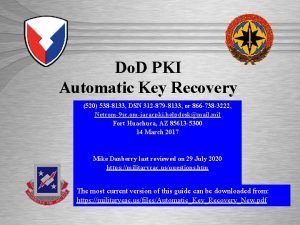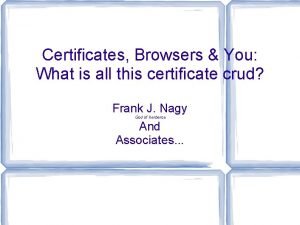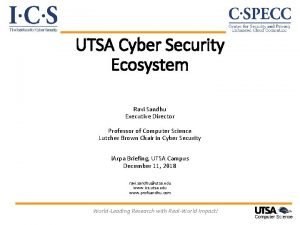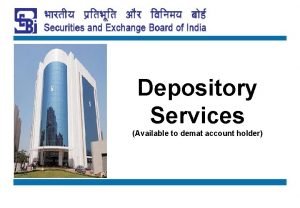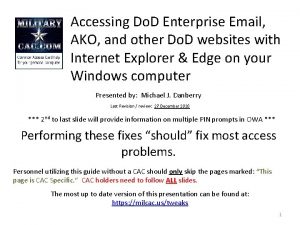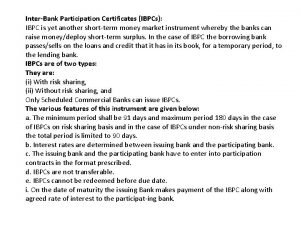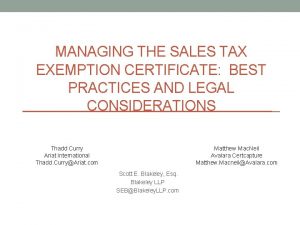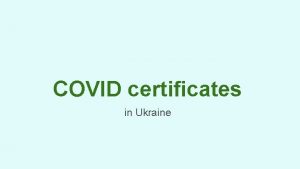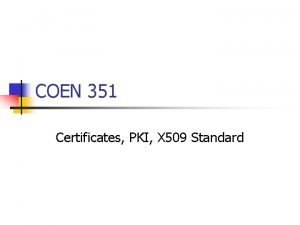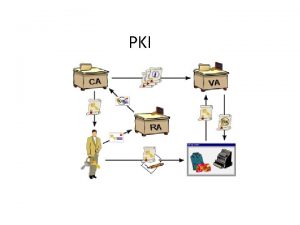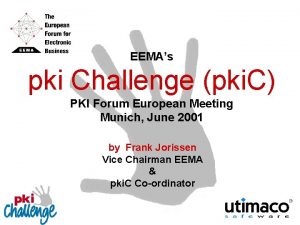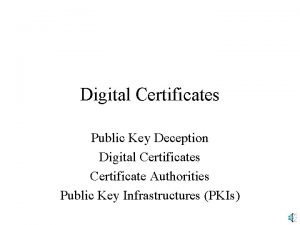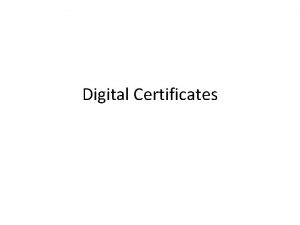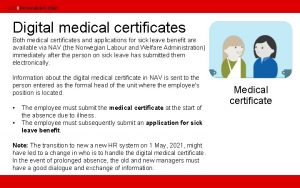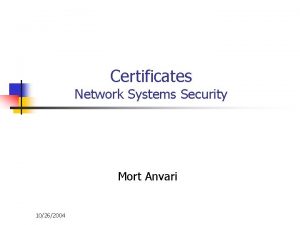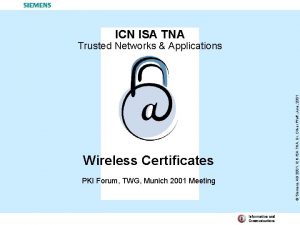Individual Digital Certificates and PKI Chris Connolly Peter

















- Slides: 17

Individual Digital Certificates and PKI Chris Connolly Peter van Dijk Galexia Consulting http: //www. galexia. com. au 1

1. Introduction ¨ Galexia Consulting ¨ Federal Privacy Commissioner’s Discussion Paper on Digital Certificates – forthcoming ¨ Importance of authentication technologies – why PKI? ¨ Scope of this presentation – focus on ‘trust’ issues 2

2. Why Public Key Technology? ¨ Public Key Technology involves the use of digital signatures. These signature are used for: – Authentication - confirm who you are – Integrity - what you sent – Non-repudiation - you can’t deny it ¨ Additionally – Confidentiality - what you can see - enables the encryption and decryption of information sent between two parties 3

2. What is PKI? ¨ Public Key Infrastructure (PKI) is the combination of software, encryption technologies (PKT), and services that enables organisations to protect the security of their communications and business transactions on the Internet ¨ PKIs integrate digital certificates, public-key cryptography, and certificate authorities into a shared network security architecture, including: – – 4 issuance of digital certificates to individual users end-user enrolment software integration with corporate certificate directories tools for managing, renewing, and revoking certificates

2. Components of a PKI http: //www. baltimore. com 5

2. Components of a PKI A PKI comprises the following components: ¨ Certificate Authorities (CAs): These are responsible for issuing and revoking certificates. ¨ Registration Authorities (RAs): These verify the binding between public keys and the identities of their holders. They conduct the initial verification of a potential subscriber’s identity and/or attributes; . ¨ Subscribers/Digital Certificate holders: People, machines or software agents that have been issued with certificates and can use them to sign digital documents. ¨ Clients: These validate digital signatures and their certification paths from a trusted CA's public key. ¨ Relying parties: Rely on the contents of a digital certificate in communicating with subscribers. ¨ Repositories/Directories: These store and make available certificates and certificate revocation lists. ¨ Security policy: This sets out and defines the organization's top-level direction on information security, as well as the processes and principles for the us of cryptography. 6

2. What is a Digital Certificate? ¨ A digital form of identification – Similar to a passport or driver’s licence – Binds subject’s public key (a mathematical value) to one or more attributes relating to their identity ¨ A certificate is valid for a period of time, (often one, three or ten years) ¨ Certificates can do different things. For example: – – 7 Encrypt a document Sign a document – for non-repudiation Secure a WWW server Provide authentication - Enable the holder to access a corporate new work

2. Example Certificate (1) ¨ Certificate Summary 8

2. Example Certificate (2) ¨ Certificate Attribute details : Key Usage 9

2. Example Certificate (3) ¨ Certificate Attribute details : Subject 10

3. PKI Models ¨ There a number of factors that differentiate PKI applications: – The level of identification (ranging from anonymous to fully identified); – The use of attributes; – The potential for multi-purpose/multi-use certificates; and – The use of online services, tokens and mobile devices. 11

3. Case Studies ¨ Case study 1 – Australian State government agency applications ¨ Case study 2 – Multi agency application ¨ Case study 3 – Health smart card ¨ Case study 4 – Patent application ¨ Case study 5 – Banking application 12

3. Case Studies - Commonwealth ¨ Australian Federal Agency applications – Centrelink – Australian Electoral Commission – Health Insurance Commission – Customs – Electronic Tenders – Jobsearch ¨ Case study 6 – The Australian Business Number – Digital Signature Certificate (ABN-DSC) 13

4. Overview of privacy implications ¨ 1. Collection, use, and disclosure of personal information – By Certification Authorities and Registration Authorities: – By Relying Parties: ¨ 2. Storage and destruction ¨ 3. Certificate Revocation Lists (CRLs) 14

4. Privacy (continued) ¨ 4. Logging of CRL lookups ¨ 5. Revocation of a certificate ¨ 6. Cooperation with law enforcement agencies ¨ 7. Access and correction rights ¨ 8. Security 15

4. Privacy (Continued) ¨ 9. Identification requirements ¨ 10. Unique identifiers ¨ 11. Potential for additional use of data (“function creep”) ¨ 12. Risk management practices ¨ 13. Limits on user choice 16

5. Conclusion ¨ Tools to build ‘trust’ in digital certificates ¨ Future trends/issues in PKI ¨ Ongoing discussion and consultation 17
 Automatic key recovery agent
Automatic key recovery agent Digital certificates in web browsers
Digital certificates in web browsers Southleeasd
Southleeasd Prashan patel grant thornton
Prashan patel grant thornton Fundamentals of web development randy connolly ppt
Fundamentals of web development randy connolly ppt Andrew connolly exeter
Andrew connolly exeter Connolly recovery audit
Connolly recovery audit Connolly lodge buckingham street
Connolly lodge buckingham street Connolly & hickey historical architects
Connolly & hickey historical architects Sucheta connolly md
Sucheta connolly md Utsa certificates
Utsa certificates Old defunct certificates surrendered for demat
Old defunct certificates surrendered for demat Pathfinder investiture ceremony script
Pathfinder investiture ceremony script Enterprise email certificates
Enterprise email certificates Certificates of currency for insurance
Certificates of currency for insurance Inter bank participation
Inter bank participation Certificate of obligation
Certificate of obligation Managing sales tax exemption certificates
Managing sales tax exemption certificates
